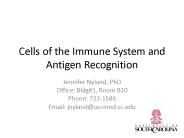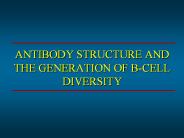Antigenic PowerPoint PPT Presentations
All Time
Recommended
Microbial Pathogenicity Antigenic Variation & Vaccine Development Kevin Coombs kcoombs@cc.umanitoba.ca Nucleic acid mutation rates Chromosomal DNA 1: 1010 - 1011 DNA ...
| PowerPoint PPT presentation | free to view
Recombination, Phase Variation and Antigenic Variation Why Recombination? Homologous Recombination General Recombination often involves a Holliday Junction Proposed ...
| PowerPoint PPT presentation | free to view
What drives antigenic drift in a single influenza season? ... DIMACS Workshop on the Epidemiology and Evolution of Influenza Rutgers University, January 26, 2006
| PowerPoint PPT presentation | free to download
Frequency of recombination between two sites is proportional to the distance between the sites. ... Tsetse fly. Rabbit 1: A B C D E etc. Rabbit 2: A B D E etc. ...
| PowerPoint PPT presentation | free to view
The Body s Defense Against HIV-Type 1 Infection, Viral Load, and Antigenic Diversity Emmanuel Jean-Jacques Seminar 475 Dr. Peter Lin Progression of AIDS Most ...
| PowerPoint PPT presentation | free to view
But at the moment we only have one time-point per subject. 4 ... NetMHC predicts CTL epitopes based on experimental binding affinity of peptides ...
| PowerPoint PPT presentation | free to download
Viruses that evolve in macaques infected with an M-tropic, NSI SIV clone derived ... co-cultivating in stimulated macaque peripheral blood mononuclear cells (PBMCs) ...
| PowerPoint PPT presentation | free to view
Theoretical and practical aspects of flaviviral antigenic structure in ... Mammalian tick-borne virus group (TBE, POW) Seabird tick-borne virus group ...
| PowerPoint PPT presentation | free to view
P. Mistry O. Parsons A. Prashar K. Wright. www.pnas.org/content/100/15.cover-expansion ... Can phosphorylation increase peptide binding affinity for HLA-A2? ...
| PowerPoint PPT presentation | free to view
Figure 22. Six MAX peptides represent 2 antigenic types. Results of ELISA tests measuring. the binding affinities of antisera against six MAX variants show that ...
| PowerPoint PPT presentation | free to view
?????? ????????? Antigenic drift. ?? ???? ?????? ?????? ??????? ???? ?? ?????????? ... ???? ????????? Antigenic shift. ??????? ?? ?????????? ???? ????? ?????? ??????? ...
| PowerPoint PPT presentation | free to view
Chapter 4 Antigens and Antibodies Ab Ag Complementarity of interacting surfaces of Ab and Ag Oct 17, 19 & 24, 2006 Antigenic determinants on Igs 3 Antigenic ...
| PowerPoint PPT presentation | free to download
... Systems Initialisation Antigenic presentation Affinity evaluation Clonal selection and expansion Affinity maturation Metadynamics Cycle Clonalg For each ...
| PowerPoint PPT presentation | free to view
Antigens Immunogen a molecule that specifically interacts with an antibody or lymphocyte and elicits an immune response Antigenic determinants (epitopes)
| PowerPoint PPT presentation | free to download
Chapter 10 Forensic Serology * * Antigens * Antigens Chemical characteristics Proteins Larger than 10,000 mw Epitopes or antigenic determinants Multivalent antigen ...
| PowerPoint PPT presentation | free to view
1. Antigen-presenting cell (APC) phagocytizes and processes antigen. Allergen (antigen) ... Allergen (antigen) TH2 cell. APC presents antigenic determinant to TH2 cell ...
| PowerPoint PPT presentation | free to view
Innate Immunity. Adaptive Immunity(acquired) Cell Mediated Immunity (CMI) Humoral Mediated Immunity (HMI) Type of Immunity ... Epitope (Antigenic determinant) ...
| PowerPoint PPT presentation | free to view
Micro organism have either pathogenic or symbiotic ... genes include enzymes that modify the antigenic structure of surface molecules, ...
| PowerPoint PPT presentation | free to view
... protein in an individual is much smaller than the potential antigenic repertoire. ... from a common primordial gene encoding the basic domain structure' ...
| PowerPoint PPT presentation | free to view
The expression of antigen receptor genes is the Key event in lymphocyte Development/Maturation ... Before Antigenic Exposure. How to code for different antibodies? ...
| PowerPoint PPT presentation | free to view
Edward Jenner developed the modern practice of vaccination when he inoculated ... B) and acellular vaccines (antigenic fraction pertussis or whooping cough) ...
| PowerPoint PPT presentation | free to view
C3b initiates formation of a membrane attack complex (MAC) ... Haptens are found in poison ivy, dander, some detergents, and cosmetics. Antigenic Determinants ...
| PowerPoint PPT presentation | free to view
C3b initiates formation of a membrane attack complex (MAC) ... Haptens are found in poison ivy, dander, some detergents, and cosmetics. Antigenic Determinants ...
| PowerPoint PPT presentation | free to view
... R on T and B cells ... Each B and T cell has receptor that is unique for a particular antigenic ... Lag in adaptive immune response. Discrimination between ...
| PowerPoint PPT presentation | free to download
Adenoid. Tonsil. Thymus. Lymph. node. Spleen. Lymphatic. vessel. Peyer's. patches. in small ... Agglutination (clumping of antigenic cells) and precipitation ...
| PowerPoint PPT presentation | free to view
Define laboratory diagnosis of HIV infection. Understand different HIV antibody assays ... The tests differ in antigenic targets and methodologies ...
| PowerPoint PPT presentation | free to view
Lymphocytes B cells Respond to cell-free and plasma membrane-bound antigens ... they can recognize and respond to a large number and types of antigenic domains. ...
| PowerPoint PPT presentation | free to view
To compare and contrast immunogen, antigen & hapten ... Some glycolipids and phospholipids can be immunogenic for T cells and illicit a ...
| PowerPoint PPT presentation | free to download
Title: Gram Reaction Subject: Gram staining Author: Hugh Fackrell Last modified by: Hugh B. Fackrell Created Date: 10/18/1996 12:08:06 PM Document presentation format
| PowerPoint PPT presentation | free to download
Title: Author: lingzhang Last modified by: xiaowuhong Created Date: 11/10/2000 8:17:50 AM Document presentation format:
| PowerPoint PPT presentation | free to view
Substance that can be recognized by immunoglobulin receptors of B cells and T ... Gell and Banacerraf (1959) compared humoral and cell mediated responses to ...
| PowerPoint PPT presentation | free to view
Title: Chapter 2 Antigen Author: Jiaxin Wang Last modified by: walkinnet Created Date: 3/14/2005 2:58:16 PM Document presentation format:
| PowerPoint PPT presentation | free to view
Chapter 4 Antigen Definitions of antigen Antigen: non-self substances which can combine with TCR or BCR or Ab and have the potential of inducing immune response .
| PowerPoint PPT presentation | free to view
Antigen Foreignness and specificity of antigen Factors that influence immunogenicity Classification of antigen Nonspecific stimuli for immune response ...
| PowerPoint PPT presentation | free to view
Cadherin family E- cadherin----- Epithelia cell N- cadherin ... (glycosylation dependent cell adhesion molecule-1) PSGL-1(P-selectin glycoprotein ...
| PowerPoint PPT presentation | free to download
... agglutination test done with a soluble antigen coated onto a particle Agglutination/Hemagglutination Inhibition Definition - test based on the inhibition of ...
| PowerPoint PPT presentation | free to download
Title: Slide 1 Author: H00MAN Last modified by: acadpm01 Created Date: 9/18/2006 6:47:29 PM Document presentation format: On-screen Show (4:3) Company
| PowerPoint PPT presentation | free to download
Antigen Processing and Presentation Cytosolic (endogenous) pathway Endocytic (exogenous) pathway Ag processing: degradation of proteins into peptides
| PowerPoint PPT presentation | free to view
They are often associated with staphylococcal products and are involved in enterotoxemia and toxic shock syndrome in humans. Superantigens (SAgs) ...
| PowerPoint PPT presentation | free to view
Lymphoid malignancies include lymphocytic leukemia and lymphoma, which are tumors that occur on lymphocytes such as B cells, T cells, and NK cells. At present, there are many difficulties in its treatment, which are related to the recurrence and refractory of the diseases in the clinic. In the past 10 years, great progress has been made in the clinical treatment of lymphatic system tumors. Anti-CD20 monoclonal antibodies have been widely used in CD20-positive B-cell non-Hodgkin's lymphomas, and have achieved good results, becoming the first-line clinical application. However, since the cell surface of lymphoma and acute-chronic lymphocytic leukemia often has only CD19 antigen, an anti-CD20 antibody such as rituximab has no obvious therapeutic effect on it, therefore there is an urgent need for a new treatment method to improve the cure rate of lymphoma and acute and chronic lymphoma.
| PowerPoint PPT presentation | free to download
Chapter 4 Antigen(Ag * * * * * * * * * * * Functional determinant: epitope existed on the surface of Ag which can be recognized by BCR or combined with Ab easily.
| PowerPoint PPT presentation | free to view
... each clone only bears a unique type of Ag receptor The clones of lymphocyte that can recognize self-Ags will be destroyed or learn to tolerance to self Ags ...
| PowerPoint PPT presentation | free to view
The macrophages engulf invaders and debris and are responsible for most of the healing. ... When the body encounters an antigen for the first time, a primary ...
| PowerPoint PPT presentation | free to view
Immunogens Or Antigens Immunogens or Antigens Immunogen or antigen: * A foreign substance, when introduced into ...
| PowerPoint PPT presentation | free to view
Trends in Biotechnology Week 13 Immunology and some uses * * The B cell uses its antibody-receptor to bind a matching antigen, which it then engulfs and processes.
| PowerPoint PPT presentation | free to download
Agglutination test It is one of important laboratory method to detect antigen antibody reaction. ... for semi quantitating of either antigen or antibody ...
| PowerPoint PPT presentation | free to download
Chapter 5 Antigen Presentation to T Lymphocytes Review: Two antigen-specific receptors: the TCR and the BCR. TCR sees antigens that were inside cells and that ...
| PowerPoint PPT presentation | free to download
Immunogen vs Antigen. immunogen induces immune response. antigen reacts with ... plasma: collect with anti-coagulants, remove cells (ie, centrifugation) ...
| PowerPoint PPT presentation | free to view
Defends against antigens and pathogens in body fluids (humors) Figure 22 ... memory cells already primed. What is the structure of. an antibody, and what types ...
| PowerPoint PPT presentation | free to view
Antigen-Antibody Reactions Antigen-antibody interactions: Are reversible specific non-covalent biochemical reactions: Hydrogen bonds (A chemical bond in which a ...
| PowerPoint PPT presentation | free to download
Antigens (foreign cells and molecules) ~ viruses ~ bacteria ...
| PowerPoint PPT presentation | free to view
Proliferation and antibody production. No proliferation ... with hydrophobic C termini. TAP-1. TAP-2. Peptide. TAP-1. TAP-2. Peptide. TAP-1. TAP-2. Peptide ...
| PowerPoint PPT presentation | free to view
Incomplete Freund's adjuvant-oil-in- water emulsion. Complete Freund's adjuvant-oil-in-water emulsion plus dead Mycobacteria. Aluminum hydroxide gel ...
| PowerPoint PPT presentation | free to view
ANTIBODY STRUCTURE AND THE GENERATION OF B-CELL DIVERSITY WHAT ARE ANTIBODIES? Antigen specific proteins produced by plasma cells Belong to immunoglobulin superfamily ...
| PowerPoint PPT presentation | free to download
Mitogen receptor ... ---Related to lymphocyte transformation test PHA( ... Na ve T cell Memory T cell Stimulation of Ag no ...
| PowerPoint PPT presentation | free to view
Immunogen- Substance capable of generating a specific immune response and ... 1000-6000D May or May not be ... Continuous/Linear-Single polypeptide segment. ...
| PowerPoint PPT presentation | free to view
























































